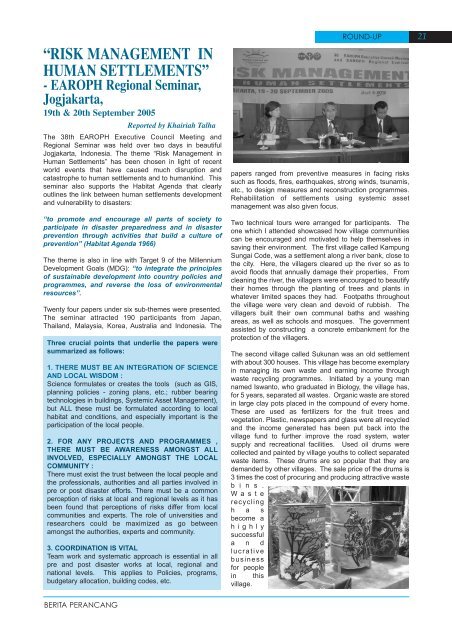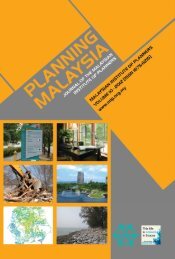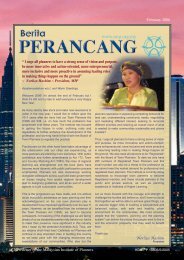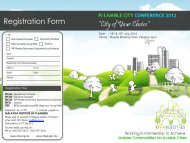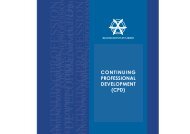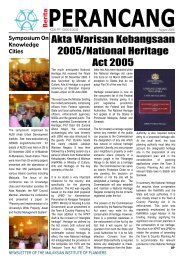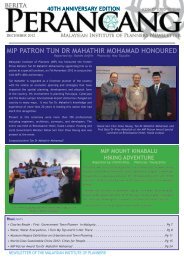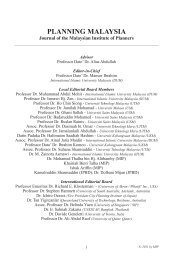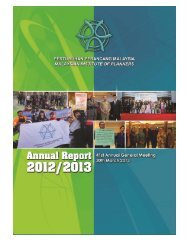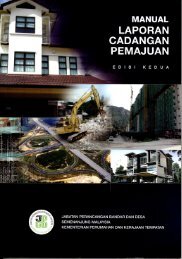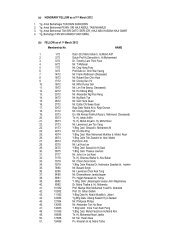Download November 2005 Issue - Malaysian Institute of Planners
Download November 2005 Issue - Malaysian Institute of Planners
Download November 2005 Issue - Malaysian Institute of Planners
Create successful ePaper yourself
Turn your PDF publications into a flip-book with our unique Google optimized e-Paper software.
“RISK MANAGEMENT INHUMAN SETTLEMENTS”- EAROPH Regional Seminar,Jogjakarta,19th & 20th September <strong>2005</strong>Reported by Khairiah TalhaThe 38th EAROPH Executive Council Meeting andRegional Seminar was held over two days in beautifulJogjakarta, Indonesia. The theme “Risk Management inHuman Settlements” has been chosen in light <strong>of</strong> recentworld events that have caused much disruption andcatastrophe to human settlements and to humankind. Thisseminar also supports the Habitat Agenda that clearlyoutlines the link between human settlements developmentand vulnerability to disasters:“to promote and encourage all parts <strong>of</strong> society toparticipate in disaster preparedness and in disasterprevention through activities that build a culture <strong>of</strong>prevention” (Habitat Agenda 1966)The theme is also in line with Target 9 <strong>of</strong> the MillenniumDevelopment Goals (MDG): “to integrate the principles<strong>of</strong> sustainable development into country policies andprogrammes, and reverse the loss <strong>of</strong> environmentalresources”.Twenty four papers under six sub-themes were presented.The seminar attracted 190 participants from Japan,Thailand, Malaysia, Korea, Australia and Indonesia. TheThree crucial points that underlie the papers weresummarized as follows:1. THERE MUST BE AN INTEGRATION OF SCIENCEAND LOCAL WISDOM :Science formulates or creates the tools (such as GIS,planning policies - zoning plans, etc.; rubber bearingtechnologies in buildings, Systemic Asset Management),but ALL these must be formulated according to localhabitat and conditions, and especially important is theparticipation <strong>of</strong> the local people.2. FOR ANY PROJECTS AND PROGRAMMES ,THERE MUST BE AWARENESS AMONGST ALLINVOLVED, ESPECIALLY AMONGST THE LOCALCOMMUNITY :There must exist the trust between the local people andthe pr<strong>of</strong>essionals, authorities and all parties involved inpre or post disaster efforts. There must be a commonperception <strong>of</strong> risks at local and regional levels as it hasbeen found that perceptions <strong>of</strong> risks differ from localcommunities and experts. The role <strong>of</strong> universities andresearchers could be maximized as go betweenamongst the authorities, experts and community.3. COORDINATION IS VITALTeam work and systematic approach is essential in allpre and post disaster works at local, regional andnational levels. This applies to Policies, programs,budgetary allocation, building codes, etc.ROUND-UP 21papers ranged from preventive measures in facing riskssuch as floods, fires, earthquakes, strong winds, tsunamis,etc., to design measures and reconstruction programmes.Rehabilitation <strong>of</strong> settlements using systemic assetmanagement was also given focus.Two technical tours were arranged for participants. Theone which I attended showcased how village communitiescan be encouraged and motivated to help themselves insaving their environment. The first village called KampungSungai Code, was a settlement along a river bank, close tothe city. Here, the villagers cleared up the river so as toavoid floods that annually damage their properties, Fromcleaning the river, the villagers were encouraged to beautifytheir homes through the planting <strong>of</strong> trees and plants inwhatever limited spaces they had. Footpaths throughoutthe village were very clean and devoid <strong>of</strong> rubbish. Thevillagers built their own communal baths and washingareas, as well as schools and mosques. The governmentassisted by constructing a concrete embankment for theprotection <strong>of</strong> the villagers.The second village called Sukunan was an old settlementwith about 300 houses. This village has become exemplaryin managing its own waste and earning income throughwaste recycling programmes. Initiated by a young mannamed Iswanto, who graduated in Biology, the village has,for 5 years, separated all wastes. Organic waste are storedin large clay pots placed in the compound <strong>of</strong> every home.These are used as fertilizers for the fruit trees andvegetation. Plastic, newspapers and glass were all recycledand the income generated has been put back into thevillage fund to further improve the road system, watersupply and recreational facilities. Used oil drums werecollected and painted by village youths to collect separatedwaste items. These drums are so popular that they aredemanded by other villages. The sale price <strong>of</strong> the drums is3 times the cost <strong>of</strong> procuring and producing attractive wasteb i n s .W a s t erecyclingh a sbecome ahighlysuccessfula n dlucrativebusinessfor peoplein thisvillage.BERITA PERANCANG


